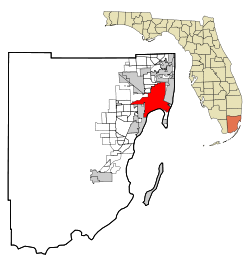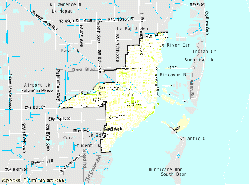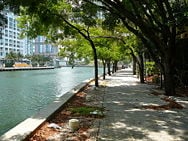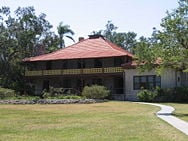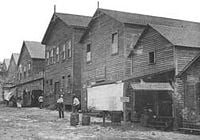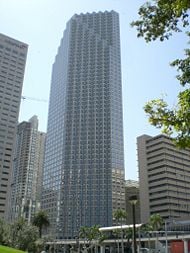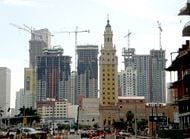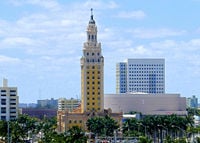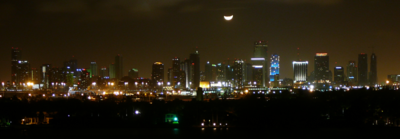Miami, Florida
| Miami | |||
| ‚ÄĒ¬†¬†City¬†¬†‚ÄĒ | |||
| City of Miami | |||
|
|||
| Nickname: "Magic City", "The Gateway to the Americas", "Capital of Latin America"[1][2] | |||
| Location in Miami-Dade County and the state of Florida | |||
| U.S. Census Bureau map showing city limits | |||
| Coordinates: 25¬į47‚Ä≤N 80¬į13‚Ä≤W | |||
|---|---|---|---|
| Country | United States | ||
| State | Florida | ||
| County | Miami-Dade | ||
| Settled | 1825 | ||
| Incorporated | July 28, 1896 | ||
| Named for | Mayaimi | ||
| Government | |||
| ¬†-¬†Type | Mayor‚Äďcommissioner plan | ||
|  - Mayor | Tomás Regalado (I) | ||
|  - City manager | Tony Crapp, Jr | ||
| Area | |||
|  - City | 55.27 sq mi (143.1 km²) | ||
|  - Land | 35.68 sq mi (92.4 km²) | ||
|  - Water | 19.59 sq mi (50.7 km²) | ||
|  - Urban | 1,116.1 sq mi (2,890.7 km²) | ||
|  - Metro | 6,137 sq mi (15,894.8 km²) | ||
| Elevation | 6 ft (2 m) | ||
| Population (2010)[3] | |||
|  - City | 399,457 (42nd) | ||
|  - Density | 12,139.5/sq mi (4,687.1/km²) | ||
|  - Urban | 5,547,051 (5th) | ||
| ZIP code(s) | 33010‚Äď33299 | ||
| Area code(s) | 305, 786 | ||
| Website: miamigov.com/home | |||
Miami is the county seat of Miami-Dade County, the most populous county in Florida. With a population of more than 409,719, Miami is the largest city within the Miami metropolitan area, which is the seventh-largest metro area in the United States with over 5.4 million residents. The United Nations estimated in 2007, that Miami had become the fourth largest urbanized area in the country, behind New York City, Los Angeles, and Chicago.
Miami is ranked as a global city for its importance in finance, commerce, media, entertainment, arts, and international trade. The city is home to the largest concentration of international banks in the United States and home to many corporate headquarters. It is an international center for popular entertainment in television, music, fashion, film, and the performing arts. The city's Port of Miami is known to accommodate the largest volume of cruise ships in the world and is the home port and headquarters to many cruise lines.
In 2008, Miami was ranked as "America's Cleanest City" according to Forbes magazine for its year-round good air quality, vast green spaces, clean drinking water, clean streets, and city-wide recycling programs. In 2008, Miami was also ranked the third-richest city in the United States in purchasing power and the world's 22nd-richest city in a UBS study.
Despite its positive statistics and reputation, Miami had the third highest incidence of family incomes below the federal poverty line in the United States in 2004, making it the third poorest city in the United States, behind only Detroit, Michigan and El Paso, Texas. Miami is also one of the least affordable places to live in the United States; the median percentage of housing costs as a percentage of income was 42.8 percent; the national average was 27 percent. Miami ranks twelfth among least affordable cities for home ownership.
Geography and cityscape
At only 35.68 square miles (92 km²) of land area, Miami has the smallest land area of any major U.S. city with a metro area population of at least 2.5 million people. It is the only major city in the United States bordered by two national parks, Everglades National Park on the west, and Biscayne National Park on the east.
Miami’s skyline ranks third in the United States, behind New York City and Chicago, and 18th in the world according to the Almanac of Architecture and Design.[4] The city has nine of the ten tallest skyscrapers in the state of Florida, the tallest being the 789-foot (240 m) Four Seasons Hotel and Tower.
Miami and its suburbs are located on a broad plain between the Everglades and Biscayne Bay that extends north to Lake Okeechobee. The elevation of the area never rises above 40 feet (12 m). The main portion of the city lies on the shores of Biscayne Bay, which contains several hundred natural and artificially created barrier islands. The Gulf Stream, a warm ocean current, runs northward just 15 miles (24.1 km) off the coast, allowing the city's climate to remain warm and mild all year.
Geology
The limestone under Miami formed as the result of drastic changes in sea level associated with recent glaciations or ice ages. Beginning some 130,000 years ago the sea levels rose to approximately 25 feet (7.5 m) above the current level. All of southern Florida was covered by a shallow sea. Several parallel lines of reef formed along the edge of the submerged Florida plateau. The area behind this reef line was in effect a large lagoon. Starting about 100,000 years ago the Wisconsin glaciation began lowering sea levels, exposing the floor of the lagoon. By 15,000 years ago, the sea level had dropped to 350 feet (110 m) below the contemporary level. The sea level rose quickly after that, stabilizing at the current level about 4,000 years ago and leaving the mainland of South Florida just above sea level.
Beneath the plain lies the Biscayne Aquifer,[5] a natural underground source of fresh water that extends from southern Palm Beach County to Florida Bay. Most of the South Florida metropolitan area obtains its drinking water from this aquifer. As a result of the aquifer, it is not possible to dig more than 15-20 feet (4.57-6.1 m) beneath the city without hitting water, which impedes underground construction. For this reason Miami has no subway system.
Climate
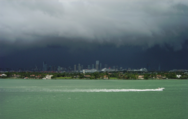
Miami has a true tropical climate with hot and humid summers and warm, mostly dry winters. The city does experience cold fronts from November through March. However, the average monthly temperature for any month has never been recorded as being under 64.4¬įF.[6] The summers are almost identical to the climate of the Caribbean tropics. The city gets most of its rain in the summer. The hurricane season largely coincides with the wet season, from May to October. Miami receives one of the highest levels of rainfall among major U.S. cities.
Due to its location between two major bodies of water known for tropical activity, Miami is also statistically the most likely major city in the world to be struck by a hurricane, trailed closely by Nassau, Bahamas, and Havana, Cuba. Despite this, the city has been fortunate in not having a direct hit by a hurricane since Hurricane Cleo in 1964. However, many other hurricanes have affected the city, including Betsy in 1965, Andrew in 1992, Irene in 1999, and Hurricanes Katrina and Wilma in 2005.
Neighborhoods
Miami is partitioned into many different sections, roughly into North, South, West and Downtown. Downtown, on the eastern side of the city, is South Florida's central business district and home of many major banks, financial headquarters, cultural and tourist attractions, and high-rise residential towers.
The southern side of Miami includes Coral Way and Coconut Grove. Coral Way is an established residential neighborhood built in 1922. Coconut Grove, established in 1825, is the location of Miami's City Hall, many nightclubs, bars, restaurants, and bohemian shops, and as such, is very popular with local college students. It has a number of parks and gardens, prestigious private schools, and historic homes and estates.
The western side of Miami includes Little Havana and is home to many of the city's traditional immigrant neighborhoods. Although at one time a mostly Jewish neighborhood, today western Miami is home to immigrants mainly from Central America and Cuba.
The northern side of Miami includes Midtown, a district with a great mix of diversity, with many West Indians, Hispanics, bohemians, and artists. The wealthier residents usually live in the northeastern part. The northern side of Miami also has notable African-American and Caribbean immigrant communities such as Little Haiti.
History
The Miami area was first inhabited for more than one thousand years by the Tequesta Indians, but was later claimed for Spain, in 1566, by Pedro Menéndez de Avilés. A Spanish mission was constructed one year later in 1567. In 1836, Fort Dallas was built, and the Miami area subsequently became a site of fighting during the Second Seminole War.
Miami holds the distinction of being the only major city in the United States founded by a woman, Julia Tuttle, who was a local citrus grower and a wealthy Cleveland native.[7] The Miami area was better known as ‚ÄúBiscayne Bay Country‚ÄĚ in the early years of its growth. Some published reports described the area as a promising wilderness. The area was also characterized as ‚Äúone of the finest building sites in Florida.‚ÄĚ The Great Freeze of 1894-1895 hastened Miami's growth, as the crops of the Miami area were the only ones in Florida that survived. Julia Tuttle subsequently convinced Henry Flagler, a railroad tycoon, to expand his Florida East Coast Railroad to the region. Miami was officially incorporated as a city on July 28, 1896, with a population of just over 300.
Miami prospered during the 1920s with an increase in population and infrastructure but weakened after the collapse of the Florida land boom of the 1920s, the 1926 Miami Hurricane, and the Great Depression in the 1930s. When World War II began, Miami, well-situated due to its location on the southern coast of Florida, played an important role in the battle against German submarines. The war helped to expand Miami’s population; by 1940, 172,172 people lived in the city. After Fidel Castro rose to power in 1959, many Cubans sought refuge in Miami, further increasing the population. In the 1980s and 1990s, various crises struck South Florida, among them the Arthur McDuffie beating and the subsequent riot, drug wars, Hurricane Andrew, and the Elián González uproar. Nevertheless, in the latter half of the twentieth century, Miami became a major international, financial, and cultural center.
Miami and its metropolitan area grew from just over one thousand residents to nearly five and a half million residents in just 110 years (1896-2006). The city’s nickname, The Magic City, comes from this rapid growth; winter visitors remarked that the city grew so much from one year to the next that it was like magic.
Economy
Miami is one of the country’s most important financial centers. It is a major center of commerce, finances, corporate headquarters, and boasts a strong international business community.
Miami International Airport and the Port of Miami are among the nation’s busiest ports of entry, especially for cargo from South America and the Caribbean. Additionally, Downtown has the largest concentration of international banks in the country, located mostly in Brickell, Miami's financial district.
Tourism is also an important industry in Miami. The beaches, conventions, festivals, and events draw over 12 million visitors annually from across the country and around the world, spending $17.1 billion.[8] The historical Art Deco district in South Beach is widely regarded as one of the most glamorous in the world for its world-famous nightclubs, beaches, historical buildings, and shopping. However, it is important to note that Miami Beach is a separate city from the City of Miami.
Miami is the home to the National Hurricane Center and the headquarters of the United States Southern Command, responsible for military operations in Central and South America. In addition to these roles, Miami is also an industrial center, especially for stone quarrying and warehousing.
According to the U.S. Census Bureau, in 2004, Miami had the third highest incidence of family incomes below the federal poverty line in the United States, making it the third poorest city in the United States, behind only Detroit, Michigan (ranked #1), and El Paso, Texas (ranked #2). Miami is also one of the very few cities where its local government went bankrupt, in 2001.[9]
In 2005, the Miami area witnessed its largest real estate boom since the 1920s. Midtown, having well over a hundred approved construction projects, is an example of this. As of 2007, however, the housing market crashed and more than 23,000 condos were for sale and/or foreclosed.[10] At the beginning of 2008 the Miami area ranks 8th in the nation in foreclosures.[11]
Miami is also one of the least affordable places to live; the median percentage of housing costs as a percentage of income was 42.8 percent; the national average was 27 percent. Miami ranks twelfth among least affordable cities for home ownership.[12]
Transportation
- Airports
Miami International Airport, one of the busiest international airports in the world, is the main airport serving the Miami metropolitan area, catering to over 35 million passengers a year. The airport is a major hub and the single largest international gateway for American Airlines, the world’s largest passenger air carrier. Miami International is the United States’ third largest international port of entry for foreign air passengers (behind New York's John F. Kennedy International Airport and Los Angeles International Airport), and is the seventh largest such gateway in the world.
- Seaports
Miami is home to one of the largest ports in the United States, the Port of Miami. It has retained its status as the number one cruise/passenger port in the world for well over a decade, accommodating the largest cruise ships and the major cruise lines. Additionally, the port is one of the nation's busiest cargo ports, importing nearly ten million tons of cargo annually. Among North American ports, it ranks second only to New Orleans in terms of cargo tonnage imported/exported from Latin America.[13]
- Public transportation
Public transportation in Miami includes commuter rail, heavy-rail rapid transit, an elevated people mover (Metromover), and buses. Miami has Florida's highest transit ridership as about 12 percent of Miami's population uses transit on a daily basis.
- Road and rail
Miami is the southern terminus of Amtrak's Atlantic Coast services, with its final station located in the suburb of Hialeah. Miami-Dade County is served by four Interstate Highways (I-75, I-95, I-195, I-395) and several U.S. highways.
Demographics
Miami is the 43rd most populous city in the U.S. The Miami metropolitan area, which includes Miami-Dade, Broward, and Palm Beach counties, had a combined population of more than 5.4 million people, ranked fourth-largest in the United States (behind Chicago, Illinois), and is the largest metropolitan area in the Southeastern United States. As of the census of 2000, there were 362,470 people, 134,198 households, and 83,336 families residing in the city. The population density was 10,160.9/mi² (3,923.5/km²).
The racial makeup of the city proper is as follows:[14]
- White: 66.6 percent (Non-Hispanic White 11.8 percent)
- Hispanic or Latino of any race: 80.8 percent
- Black (many of whom are from the Caribbean): 22.3 percent
- Some other races: 5.4 percent
- Two or more races: 4.74 percent
- Asian: 0.7 percent
- Pacific Islander: 0.04 percent
- Native American: 0.2 percent
As of 2000, in terms of national origin and/or ethnic origin, 34.1 percent of the populace was Cuban, while 5.6 percent of the city's population was Nicaraguan, 5.5 percent of the population was Haitian, 3.3 percent of the population was Honduran, 1.7 percent of all residents were Dominican, and 1.6 percent of the population was Colombian.[15] In 2004, the United Nations Development Program (UNDP) ranked Miami first in terms of percentage of residents born outside of the country it is located in (59 percent), followed by Toronto (50 percent).
There were 134,198 households out of which 26.3 percent had children under the age of 18 living with them, 36.6 percent were married couples living together, 18.7 percent have a female head of household with no husband present, and 37.9 percent were non-families. 30.4 percent of all households were made up of individuals and 12.5 percent had someone living alone who was 65 years of age or older. The average household size was 2.61 and the average family size was 3.25. The age distribution was 21.7 percent under the age of 18, 8.8 percent from 18 to 24, 30.3 percent from 25 to 44, 22.1 percent from 45 to 64, and 17.0 percent who were 65 years of age or older. The median age was 38 years. For every 100 females there were 98.9 males. For every 100 females age 18 and over, there were 97.3 males.
The median income for a household in the city was $23,483, and the median income for a family was $27,225. Males had a median income of $24,090 versus $20,115 for females. The per capita income for the city was $15,128. About 23.5 percent of families and 28.5 percent of the population were below the poverty line, including 38.2 percent of those under age 18 and 29.3 percent of those age 65 or over.
Miami’s explosive population growth in recent years has been driven by internal migration from other parts of the country as well as by immigration. Miami is regarded as more of a multicultural mosaic, than it is a melting pot, with residents still maintaining much, or some, of their cultural traits. The overall culture of Miami is heavily influenced by its large population of ethnic Latin Americans and cultures from Caribbean islands such as Jamaica, Trinidad and Tobago, Bahamas, and Cuba; many of whom spoke Spanish or Haitian Creole.
Today, the Miami area has a sizable community of citizens, undocumented populations, and permanent residents, of Argentines, Bahamians, Brazilians, Canadians, Chileans, Chinese, Colombians, Cubans, Dominicans, Ecuadorans, French, Germans, Greeks, Guatemalans, Guayanese, Haitians, Hondurans, Jamaicans, Indians, Italians, Mexicans, Nicaraguans, Peruvians, Russians, Salvadoran, Trinidadians and Tobagonians, Turks, South Africans, and Venezuelans, as well as a sizable Puerto Rican population throughout the metropolitan area.
While commonly thought of as mainly a city of Hispanic and Caribbean immigrants, the Miami area is home to large French, French Canadian, German, Italian, and Russian communities. The communities have grown to a prominent place in Miami and its suburbs, creating ethnic enclave neighborhoods such as Little Haiti, Little Havana, Little Managua, Little Brazil, Little Moscow, and Little San Juan.
Languages
A wide variety of languages are commonly spoken throughout the city. Miami has the largest Spanish-speaking population in the Western Hemisphere outside Latin America.[16]
As of 2000, speakers of Spanish as their first language accounted for 66.75 percent of residents, while English was spoken by 25.45 percent, French Creole by 5.20 percent, and French speakers comprised 0.76 percent of the population.[17] Other languages that were spoken throughout the city include Portuguese at 0.41 percent, German at 0.18 percent, Italian at 0.16 percent, Arabic at 0.15 percent, Chinese at 0.11 percent, and Greek at 0.08 percent of the population. Miami also has one of the largest percentage populations in the U.S. that have residents who speak first languages other than English at home, 74.54 percent.[17]
Culture
Miami is home to many entertainment venues, theaters, museums, parks, and performing arts centers. The newest addition to the Miami arts scene is the Adrienne Arsht Center for the Performing Arts, the second-largest performing arts center in the United States after Lincoln Center in New York City. The center attracts many large-scale operas, ballets, concerts, and musicals from around the world.
The city is home to numerous museums, many of which are in the Downtown area. There are over 80 parks in Miami. The largest and most popular parks are Bayfront Park and Bicentennial Park (located in the heart of Downtown), Fairchild Tropical Botanic Garden, Tropical Park, Watson Island, and Morningside Park.
Miami music is varied. Cubans brought the conga and rumba to Miami. Dominicans brought bachata and merengue, while Colombians brought vallenato. West Indians and Caribbeans have brought reggae, soca, kompa, zouk, calypso, and steel pan to the area as well.
Miami is the headquarters and main production city of many of the world's largest television networks, broadcasting companies and production facilities, such as Telemundo, TeleFutura, Mega TV, Univision, RCTV International, and Sunbeam Television.
Like many other major U.S. cities, Miami has an above average crime rate. The highest crime rates were in the late 1970s and early 1980s during the "Cocaine Cowboy" era, since Miami was where the majority of cocaine and crack entered the United States from Colombia. In the early 1980s, Miami was considered America's murder capital due to all the drug related murders going on at the time. From this Miami developed its own organized crime.
Notes
- ‚ÜĎ Cathy Booth and Timothy Long, Miami: the Capital of Latin America TIME Magazine (December 2, 1993). Retrieved May 17, 2012.
- ‚ÜĎ Colin Brown, Shore Bet CNBC Business (April, 2011). Retrieved May 17, 2012.
- ‚ÜĎ US Census Bureau, Miami (city), Florida, State & County QuickFacts. Retrieved May 17, 2012.
- ‚ÜĎ Egbert Gramsbergen and Paul Kazmierczak, The World's Best Skylines. Retrieved October 20, 2008.
- ‚ÜĎ United States Geological Survey, Ground Water Atlas of the United States‚ÄĒAlabama, Florida, Georgia, South Carolina. Retrieved October 20, 2008.
- ‚ÜĎ Country Studies, Miami Weather, monthly mean chart. Retrieved October 20, 2008.
- ‚ÜĎ Infoplease.com, Julia Tuttle. Retrieved October 20, 2008.
- ‚ÜĎ Lou Ortiz, Record number of local visitors, record spending achieved in 2007, Miami Today. Retrieved October 20, 2008.
- ‚ÜĎ Adam Cohen, June 24, 2001, Gloom over Miami, Time Magazine. Retrieved October 20, 2008.
- ‚ÜĎ Maya Bell, August 27, 2007, Boom of condo crash loudest in Miami. Retrieved August 30, 2007.
- ‚ÜĎ Tampa Bay Business Journal, February 13, 2008, Florida markets rank high in national foreclosure volume. Retrieved October 20, 2008.
- ‚ÜĎ American City Business Journals, Inc, March 8, 2007, Where‚Äôs the least expensive place to own a home? Retrieved October 20, 2008.
- ‚ÜĎ Miami-Dade County, Cruise Capital of the World.
- ‚ÜĎ United States Census Bureau, QuickFacts for Miami (city), Florida. Retrieved October 20, 2008.
- ‚ÜĎ ePodunk Inc, October-November, 2005, Ancestry Maps.
- ‚ÜĎ Gerald Erichson, Where is Spanish Spoken, About.com. Retrieved October 20, 2008.
- ‚ÜĎ 17.0 17.1 Modern Language Association, Data Center Results‚ÄĒMiami, Florida. Retrieved October 20, 2008.
ReferencesISBN links support NWE through referral fees
- Chang, Perry. 1998. Florida. New York: Marshall Cavendish. ISBN 0761404201.
- Heinrichs, Ann. 1998. Florida. New York: Children's Press. ISBN 051620632X.
- Orr, Tamra B. 2008. Florida. New York: Children's Press. ISBN 9780531185582.
- Van Riper, Tom. March 17, 2008. America's cleanest cities. Forbes Magazine. Retrieved October 20, 2008.
Credits
New World Encyclopedia writers and editors rewrote and completed the Wikipedia article in accordance with New World Encyclopedia standards. This article abides by terms of the Creative Commons CC-by-sa 3.0 License (CC-by-sa), which may be used and disseminated with proper attribution. Credit is due under the terms of this license that can reference both the New World Encyclopedia contributors and the selfless volunteer contributors of the Wikimedia Foundation. To cite this article click here for a list of acceptable citing formats.The history of earlier contributions by wikipedians is accessible to researchers here:
The history of this article since it was imported to New World Encyclopedia:
Note: Some restrictions may apply to use of individual images which are separately licensed.



